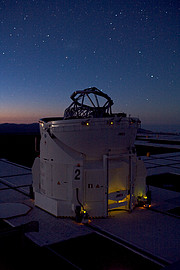Pressemeddelelse
Little Brother Joins the Large Family
First Light for VLT's Auxiliary Telescope No.4
22. december 2006
On the night of 15 December 2006, the fourth and last-to-be-installed VLTI Auxiliary Telescope (AT4) obtained its 'First Light'. The first images demonstrate that AT4 will be able to deliver the excellent image quality already delivered by the first three ATs. It will soon join its siblings to perform routinely interferometric measurements.
The VLT is composed of four 8.2-m Unit Telescope (Antu, Kueyen, Melipal and Yepun). They have been progressively put into service together with a vast suite of the most advanced astronomical instruments and are operated every night in the year.
Contrary to other large astronomical telescopes, the VLT was designed from the beginning with the use of interferometry as a major goal. The VLT Interferometer (VLTI) combines starlight captured by two or three 8.2- VLT Unit Telescopes, dramatically increasing the spatial resolution and showing fine details of a large variety of celestial objects.
One AT Under the Sky
However, most of the time the large telescopes are used for other research purposes. They are therefore only available for interferometric observations during a limited number of nights every year. Thus, in order to exploit the VLTI each night and to achieve the full potential of this unique setup, some other (smaller), dedicated telescopes were included into the overall VLT concept.
These telescopes, known as the VLTI Auxiliary Telescopes (ATs), are mounted on tracks and can be placed at precisely defined "parking" observing positions on the observatory platform. From these positions, their light beams are fed into the same common focal point via a complex system of reflecting mirrors mounted in an underground system of tunnels.
The Auxiliary Telescopes are real technological jewels. They are placed in ultra-compact enclosures, complete with all necessary electronics, an air conditioning system and cooling liquid for thermal control, compressed air for enclosure seals, a hydraulic plant for opening the dome shells, etc. Each AT is also fitted with a transporter that lifts the telescope and relocates it from one station to another. It moves around with its own housing on the top of Paranal, almost like a snail.
The VLTI is arguably the world's most advanced optical device of this type. It has already demonstrated its powerful capabilities by addressing several key scientific issues, such as determining the size and the shape of a variety of stars, measuring distances to stars, probing the innermost regions of the proto-planetary discs around young stars or making the first detection by infrared interferometry of an extragalactic object.
Om pressemeddelelsen
| Pressemeddelelse nr.: | eso0651 |
| Legacy ID: | PR 51/06 |
| Navn: | Auxiliary Telescopes, Very Large Telescope Interferometer |
| Type: | Unspecified : Technology : Observatory : Telescope |
| Facility: | Very Large Telescope |
Our use of Cookies
We use cookies that are essential for accessing our websites and using our services. We also use cookies to analyse, measure and improve our websites’ performance, to enable content sharing via social media and to display media content hosted on third-party platforms.
ESO Cookies Policy
The European Organisation for Astronomical Research in the Southern Hemisphere (ESO) is the pre-eminent intergovernmental science and technology organisation in astronomy. It carries out an ambitious programme focused on the design, construction and operation of powerful ground-based observing facilities for astronomy.
This Cookies Policy is intended to provide clarity by outlining the cookies used on the ESO public websites, their functions, the options you have for controlling them, and the ways you can contact us for additional details.
What are cookies?
Cookies are small pieces of data stored on your device by websites you visit. They serve various purposes, such as remembering login credentials and preferences and enhance your browsing experience.
Categories of cookies we use
Essential cookies (always active): These cookies are strictly necessary for the proper functioning of our website. Without these cookies, the website cannot operate correctly, and certain services, such as logging in or accessing secure areas, may not be available; because they are essential for the website’s operation, they cannot be disabled.
Functional Cookies: These cookies enhance your browsing experience by enabling additional features and personalization, such as remembering your preferences and settings. While not strictly necessary for the website to function, they improve usability and convenience; these cookies are only placed if you provide your consent.
Analytics cookies: These cookies collect information about how visitors interact with our website, such as which pages are visited most often and how users navigate the site. This data helps us improve website performance, optimize content, and enhance the user experience; these cookies are only placed if you provide your consent. We use the following analytics cookies.
Matomo Cookies:
This website uses Matomo (formerly Piwik), an open source software which enables the statistical analysis of website visits. Matomo uses cookies (text files) which are saved on your computer and which allow us to analyze how you use our website. The website user information generated by the cookies will only be saved on the servers of our IT Department. We use this information to analyze www.eso.org visits and to prepare reports on website activities. These data will not be disclosed to third parties.
On behalf of ESO, Matomo will use this information for the purpose of evaluating your use of the website, compiling reports on website activity and providing other services relating to website activity and internet usage.
Matomo cookies settings:
Additional Third-party cookies on ESO websites: some of our pages display content from external providers, e.g. YouTube.
Such third-party services are outside of ESO control and may, at any time, change their terms of service, use of cookies, etc.
YouTube: Some videos on the ESO website are embedded from ESO’s official YouTube channel. We have enabled YouTube’s privacy-enhanced mode, meaning that no cookies are set unless the user actively clicks on the video to play it. Additionally, in this mode, YouTube does not store any personally identifiable cookie data for embedded video playbacks. For more details, please refer to YouTube’s embedding videos information page.
Cookies can also be classified based on the following elements.
Regarding the domain, there are:
- First-party cookies, set by the website you are currently visiting. They are stored by the same domain that you are browsing and are used to enhance your experience on that site;
- Third-party cookies, set by a domain other than the one you are currently visiting.
As for their duration, cookies can be:
- Browser-session cookies, which are deleted when the user closes the browser;
- Stored cookies, which stay on the user's device for a predetermined period of time.
How to manage cookies
Cookie settings: You can modify your cookie choices for the ESO webpages at any time by clicking on the link Cookie settings at the bottom of any page.
In your browser: If you wish to delete cookies or instruct your browser to delete or block cookies by default, please visit the help pages of your browser:
Please be aware that if you delete or decline cookies, certain functionalities of our website may be not be available and your browsing experience may be affected.
You can set most browsers to prevent any cookies being placed on your device, but you may then have to manually adjust some preferences every time you visit a site/page. And some services and functionalities may not work properly at all (e.g. profile logging-in, shop check out).
Updates to the ESO Cookies Policy
The ESO Cookies Policy may be subject to future updates, which will be made available on this page.
Additional information
For any queries related to cookies, please contact: pdprATesoDOTorg.
As ESO public webpages are managed by our Department of Communication, your questions will be dealt with the support of the said Department.



